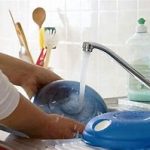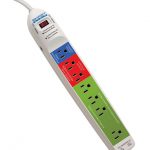There are many reasons we should think about our home energy efficiency, from the environmental and financial benefits of cutting energy use to potential health improvements.
Here are the ten most common ways to conserve energy and save electricity in your home, listed from the simplest to the most intensive strategies.
1. Adjust your day-to-day behaviors
 Energy conservation can be as simple as turning off lights or appliances when you do not need them. You can also use energy eating appliances less by doing household tasks manually, such as hang-drying your clothes instead of putting them in the dryer, or washing dishes by hand.
Energy conservation can be as simple as turning off lights or appliances when you do not need them. You can also use energy eating appliances less by doing household tasks manually, such as hang-drying your clothes instead of putting them in the dryer, or washing dishes by hand.
The behavior adjustments that have the highest potential for utility savings are turning down the heat on your thermostat in the winter and using your air conditioner less in the summer. Heating and cooling costs make up almost half of an average home’s utility bills, so these reductions in the intensity and frequency of heating and cooling offer the greatest savings.
There are tools you can use to figure out where most of your electricity is going in your home. A home energy monitor can help you understand which appliances are using the most electricity on a day-to-day basis.
2. Replace your light bulbs
Traditional incandescent light bulbs use a lot of electricity and need to be replaced more often than more energy efficient alternatives. Halogen incandescent bulbs, compact fluorescent lights (CFLs), and light-emitting diode bulbs (LEDs) use anywhere from 25-80% less electricity and last three to 25 times longer than traditional bulbs.
Energy efficient bulbs are more expensive to buy, but because of their efficient energy use and longer lives they cost less in the long run.
3. Use smart power strips
 “Phantom loads,” or the electricity used by electronics when they are turned off or in standby mode, are a major source of energy waste. In fact, it is estimated that 75% of the energy used to power household electronics is consumed when they are switched off. Smart power strips, also known as advanced power strips, eliminate the problem of phantom loads by shutting off the power to electronics when they are not in use. Smart power strips can be set to turn off at an assigned time, during a period of inactivity, through remote switches, or based on the status of a “master” device.
“Phantom loads,” or the electricity used by electronics when they are turned off or in standby mode, are a major source of energy waste. In fact, it is estimated that 75% of the energy used to power household electronics is consumed when they are switched off. Smart power strips, also known as advanced power strips, eliminate the problem of phantom loads by shutting off the power to electronics when they are not in use. Smart power strips can be set to turn off at an assigned time, during a period of inactivity, through remote switches, or based on the status of a “master” device.
4. Install a programmable or smart thermostat
A programmable or smart thermostat can be set to automatically turn off or reduce heating and cooling during the times when you are asleep or away. When you install a programmable thermostat, you remove wasteful energy use from heating and cooling without upgrading your HVAC system or losing any comfort.
Programmable thermostats come in different models that can be set to fit your weekly schedule. Additional features of programmable thermostats can include indicators for when to replace air filters or HVAC system problems, which also improve the efficiency of your heating and cooling system.
5. Buy energy efficient appliances
On average, appliances are responsible for roughly 13% of your total  household energy use. When purchasing an appliance, you should pay attention to two numbers: the initial purchase price and the annual operating cost. Although energy efficient appliances usually have higher purchase prices, their operating costs are significantly lower than conventional models.
household energy use. When purchasing an appliance, you should pay attention to two numbers: the initial purchase price and the annual operating cost. Although energy efficient appliances usually have higher purchase prices, their operating costs are significantly lower than conventional models.
When purchasing an energy efficient appliance, you should look for appliances with the ENERGY STAR label, which is a federal guarantee that the appliance will consume less energy during use and when on standby than standard non-energy efficient models. Energy savings differ based on the specific appliance.
6. Reduce your water heating expenses
Water heating is a major contributor to your total energy consumption. Other than purchasing an energy efficient water heater, there are three methods of reducing your water heating expenses: you can simply use less hot water, turn down the thermostat on your water heater, or insulate your water heater and the first six feet of hot and cold water pipes.
If you are considering replacing your water heater with an efficient model, you should keep in mind two factors: the type of water heater that meets your needs and the type of fuel it will use. For example, tankless water heaters are energy efficient, but they are also a poor choice for large families as they cannot handle multiple and simultaneous uses of hot water. Efficient water heaters can be anywhere between 8% and 300% more energy efficient than a conventional storage water heater. Also, be sure to account for its lengthy service life of 10 to 15 years in which water-heating savings can accumulate.
7. Install energy efficient windows
Windows are another significant source of energy waste. To prevent heat loss through your windows, you can replace single-pane windows with double-pane ones.
For homes in cold regions, like New Hampshire, gas-filled windows with “low-e” coatings can significantly reduce your heating expenses. In addition, interior or exterior storm windows can reduce unnecessary heat loss. You should especially consider storm windows if your region experiences frequent extreme weather events.
During warmer months, heat gain through windows may be a concern. In addition to minimizing heat loss, low-e coatings on windows can reduce heat gain by reflecting more light and lowering the amount of thermal energy diffused into your home. Window shades, shutters, screens, and awnings can also provide an extra layer of insulation between your home and external temperatures.
8. Upgrade your HVAC system
An HVAC system is composed of heating, ventilation, and air conditioning equipment. Heating alone is responsible for more than 40% of home energy use. Because homes in northern regions are exposed to much colder temperatures during the year, ENERGY STAR gas furnaces have different specifications in the northern and southern halves of the United States.
ENERGY STAR furnaces in the northern half of the U.S. are labeled with the standard ENERGY STAR logo and are up to 16% more energy efficient than baseline models.
Air conditioning, by comparison, isn’t a significant contributor to energy bills. ENERGY STAR central air conditioning units are eight percent more efficient than conventional models. Air conditioning systems are usually integrated with heating systems, which means you should purchase your new furnace and air conditioner at the same time in order to ensure that the air conditioner performs at its maximum rated energy efficiency.
Upgrades to the third component of an HVAC system – ventilation – can also improve your energy efficiency. A ventilation system is composed of a network of ducts, which distributes hot and cold air throughout your home. If these ducts are not properly sealed or insulated, the resulting energy waste can add hundreds of dollars to your annual heating and cooling expenses. Proper insulation and maintenance on your ventilation system can reduce your heating and cooling expenses by up to 20%.
9. Weatherize your home
Weatherizing, or sealing air leaks around your home, is a great way to reduce your heating and cooling expenses. The most common sources of air leaks into your home are vents, windows, and doors. To prevent these leaks, you should ensure there are no cracks or openings between the wall and vent, window, or doorframe.
To seal air leaks between stationary objects, such as the wall and window frame, you can apply caulk. For cracks between moving objects, such as operable windows and doors, you can apply weather stripping. Weather stripping and caulking are simple air sealing techniques that typically offer a return on investment in less than a year. Air leaks can also occur through openings in the wall, floor, and ceiling from plumbing, ducting, or electrical wiring.
Air leaking out of your home is most often from the home interior into your attic through small openings. Whether it is through ducts, light fixtures, or the attic hatch, hot air will rise and escape through small openings. Because heat rises, these small openings can make your heating bill even higher if your attic is not sufficiently insulated. To maximize the amount of savings from weatherization, you should consider fully insulating your home.
10. Insulate your home
Insulation plays a key role in lowering your utility bills through keeping in heat during the winter and keeping heat out of your home during the summer. The recommended level of heat resistance, or “R-value,” for your insulation depends on where you live. In warmer climates, the recommended R-value is much lower than for buildings located in colder regions like the Northeast.
The level of insulation you should install depends on the area of your house. Your attic, walls, floors, basement, and crawlspace are the five main areas where you should consider adding insulation.